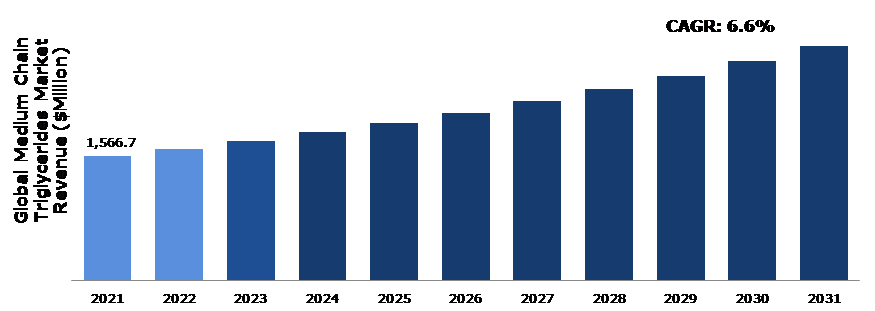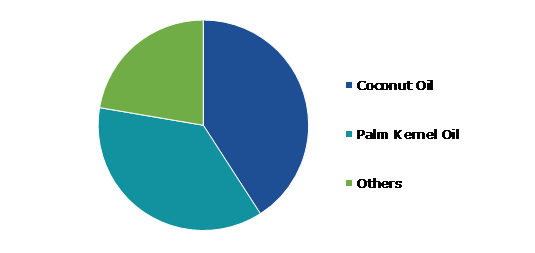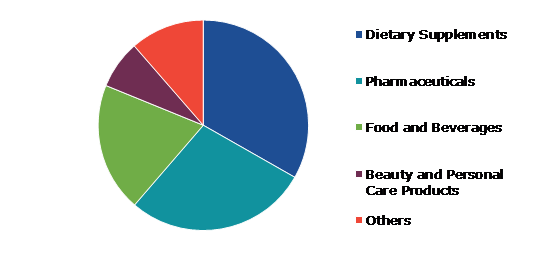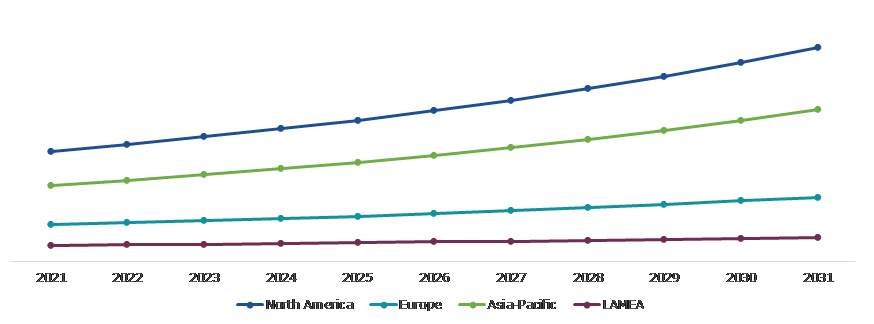Medium Chain Triglycerides Market Report
RA04419
Medium Chain Triglycerides Market by Type (Caproic Acid, Caprylic Acid, Capric Acid, and Lauric Acid), Source (Coconut Oil, Palm Kernel Oil, and Others), Application (Dietary Supplements, Pharmaceuticals, Food and Beverages, Beauty and Personal Care Products, and Others), and Regional Analysis (North America, Europe, Asia-Pacific, and LAMEA): Global Opportunity Analysis and Industry Forecast, 2022–2031
Global Medium Chain Triglycerides Market Analysis
The Global Medium Chain Triglycerides Market Size was $1,566.7 million in 2021 and is predicted to grow with a CAGR of 6.6%, by generating a revenue of $2,959.9 million by 2031.
Global Medium Chain Triglycerides Market Synopsis
The increasing demand for medium chain triglycerides (MCTs) is majorly attributed to the rising demand for MCT in various applications such as dietary supplements and beauty & personal care products. Enhanced standard of living along with the rising adoption of a healthy lifestyle by consumers is augmenting the demand for dietary supplements across the globe. There is a rising inclination by consumers toward using ketogenic supplements such as medium-chain triglycerides (MCT), to achieve intermittent ketosis without sticking to a tough ketogenic diet. MCT supplementation is an affordable and simple ketogenic intervention, proven to benefit both people with normal cognition and those suffering from mild cognitive impairment, Alzheimer's disease, and other illnesses. Many studies have shown that MCT supplementation of a regular diet has a significant effect on cognition, both in healthy individuals and those suffering from mild cognitive impairment (MCI), Alzheimer's disease (AD), and other neurological disorders. In addition, substituting other dietary fats with MCTs may offer remarkable metabolic advantages in individuals with type 2 diabetes. All these aspects are expected to augment the demand of the market during the forecast period.
When ingested or administered intravenously, MCTs are generally safe for most people. However, they may result in adverse effects such as nausea, diarrhea, stomach discomfort, bloating, and intestinal gas. These factors are likely to hinder market growth during the forecast period.
The rise in demand for beauty and personal care products across the globe is expected to offer ample growth opportunities. MCT is a natural emollient that gives skin a silky texture and is non-greasy. It is highly versatile and suited for many skin types. Typical applications of MCT for personal care are lip care, hair care, skin care, cosmetics, and massage products.
Medium Chain Triglycerides Market Overview
Lipid molecules known as medium-chain triglycerides (MCTs) are more easily oxidized and absorbed than most lipids. MCTs contain a glycerol molecule connected to 3 fatty acid chains varying between 6-12 carbons in length. MCTs are more readily taken into the bloodstream from the digestive tract than most other lipid molecules, which demand a difficult digesting process. MCTs occur naturally in dairy products and whole foods, but they are also manufactured for their value as a healthier dietary fat.
COVID-19 Impact on Medium Chain Triglycerides Market
The COVID-19 pandemic had a moderate impact on the medium chain triglycerides market. During the initial two quarters of 2020, the dietary supplements, personal care, as well as food and beverage industries were impacted across the world. The use of MCTs is significant for various applications in the food & beverage, personal care, and dietary supplements industries. However, due to lockdowns, social distancing, quarantine, travel bans, and supply chain disruptions, this industry's growth was hampered severely. This in turn, ultimately impacted the medium chain triglycerides market. However, post-pandemic, the demand from the above industries recovered significantly and is expected to increase further. In addition, due to increased health awareness, consumers increasingly opting for premium goods, which further facilitates producers to use MCTs in their food items. Increased health awareness is related to COVID-19, which facilitates consumers to buy more private-label products. Due to more health awareness after the outbreak, consumers are exploring more healthy diets.
Rising Adoption of MCTs as a Substitute to Fats in Diets to Drive the Market
MCTs are naturally present in palm kernel oil, milk fat, and coconut oil. Interest in MCTs as a substitute for fats in diets has increased significantly in the last few years. MCTs oil possesses a lot of these fats and has several health benefits. Salad dressings, baking, and soups may all be prepared with MCT oil. Further, it can be used to lightly fry food, mainly oil-absorbent items such as mushrooms, tomatoes, aubergines, or marrow. For individuals who cannot digest other forms of fat, MCTs provide a source of fat. Because the body can more quickly convert these fats into ketone bodies, they may also aid in weight loss. MCT oil has become a prevalent supplement among bodybuilders and athletes.
Availability of Other Substitutes such as Mineral Oils in Cosmetic Applications May Limit the Market Growth
Mineral oils are frequently used in cosmetic applications because they provide a wide range of viscosity options that enable viscosity regulation of a formulation, they have protective and lubricating properties that prevent skin dehydration, and they are stable. In comparison to MCTs, mineral oil is a less expensive moisturizing agent, making it a crucial component of traditional skincare and beauty products. Mineral oils have been safely used in cosmetics for more than 100 years. Compared to MCTs, they are more well-tolerated and haven't been linked to any allergies.
Rising Demand from Pharmaceuticals and Cosmetics Industry is Anticipated to Offer Lucrative Growth Opportunities
There are numerous uses for MCTs. They can be utilized as a base for pharmacological agents with a variety of dosage forms available of a drug – such as tablets, capsules, soft gel capsules, lotions, ointments, and creams. People who cannot properly digest foods use MCTs. This includes individuals who are sensitive to gluten or lactose, who have unintentional weight loss, or who require more calories for other medical conditions. MCTs don't have any carbs or protein. In the creation of cosmetics, medium-chain triglycerides are also employed as emollients and transporters. During the projection period, all of these elements are anticipated to present attractive prospects.
Global Medium Chain Triglycerides Market, by Type
Based on type, the market is further divided into caproic acid, caprylic acid, capric acid, and lauric acid. Among this, the caprylic acid sub-segment held largest market share in 2021 and is anticipated to show a fastest CAGR during the forecast period.
Global Medium Chain Triglycerides Market Size, by Type, 2021
The caprylic acid sub-segment is anticipated to show the fastest CAGR during the forecast period. Coconut and palm kernel oil both contain caprylic acid, a saturated fatty acid with an 8-carbon chain. Caprylic acid is a medium-chain fatty acid and possesses excellent antibacterial, antifungal, and anti-inflammatory properties. These characteristics make caprylic acid an effective treatment for various ailments such as skin diseases, digestive issues, yeast infections, and excessive cholesterol. Caprylic acid functions as a ketogenic substance and is designed to get around problems with metabolism. Caprylic acid in the diet is safe and the most common side effects of this prescription meal are moderate digestive issues and diarrhea.
Global Medium Chain Triglycerides Market, by Source
Based on source, the global medium chain triglycerides market has been divided into coconut oil, palm kernel oil, and others. Among these, the coconut oil sub-segment accounted for largest market share in 2021 and is anticipated to show a fastest CAGR during the forecast period.
Global Medium Chain Triglycerides Market Share, by Source, 2021
The coconut oil sub-segment is expected to have the fastest growth during the forecast period. MCTs are most commonly extracted from coconut oil as more than 50% of the fat in coconut oil comes from MCTs. Fractionation is a method used to create MCT oil from coconut oil. This isolates the MCT from the coconut oil and concentrates it. MCT oil has grown in popularity as a dietary supplement in the last few years due to a variety of health advantages, including improved athletic performance, increased energy, and weight loss. In addition, the popularity of the ketogenic diet and the increasing studies on the advantages of coconut oil are some of the major factors contributing to the growth of MCT oil.
Global Medium Chain Triglycerides Market, by Application
Based on application, the global medium chain triglycerides market has been divided into dietary supplements, pharmaceuticals, food and beverages, beauty and personal care products, and others. Among these, the dietary supplements sub-segment accounted for largest market share in 2021.
Global Medium Chain Triglycerides Market Growth, by Application, 2021
The dietary supplements sub-segment is expected to have the fastest growth during the forecast period. MCT aids in enhancing a person's metabolism, which may lead to weight loss. It can also aid in boosting athletic performance by reducing lactate levels. In addition, MCT oil can help to increase the strength of old and weak people. Ketones are a carb-free energy source for the brain that MCT can aid the body in producing. MCT might potentially be utilized to treat skin infections. The lauric acid in MCT acts as an antibacterial agent, eradicating bacteria and viruses by dissolving their cell walls. Owing to all these advantages of MCT, their use in dietary supplements is expected to increase during the forecast period.
Global Medium Chain Triglycerides Market, Regional Insights
The medium chain triglycerides market was investigated across North America, Europe, Asia-Pacific, and LAMEA.
Global Medium Chain Triglycerides Market Size & Forecast, by Region, 2021-2031 (USD Million)
North America Dominated the Medium Chain Triglycerides Market in 2021
The North America region dominated the global medium chain triglycerides market in 2021. The rise in demand for medium chain triglycerides in this region is majorly attributed to growing demand for dietary supplements, cosmetics, and beauty products among millennials. Numerous major dietary supplements providers are present in the U.S. In addition, busy lifestyles, robust per capita income, and increasing health consciousness is expected to augment the demand for dietary supplement in this region. This in turn, ultimately offers excellent opportunities in this region.
Global Medium Chain Triglycerides Market Competitive Scenario
Joint ventures, investment, merger & acquisition, product development, and technological development are the common strategies followed by major medium chain triglycerides market players. For instance, in 2021, Croda International PLC acquired Alban Muller, to grow its portfolio of active ingredients utilized in personal care products and cosmetics.
Some of the leading players in the medium chain triglycerides market are BASF SE, DuPont, Lonza Group Ltd., Croda International Plc, P&G Chemicals, Wilmar International Ltd., Stepan Company, Sternchemie GmbH & Co. KG, Koninklijke DSM N.V., and Emery Oleochemicals.
| Aspect | Particulars |
| Historical Market Estimations | 2020 |
| Base Year for Market Estimation | 2021 |
| Forecast timeline for Market Projection | 2022-2031 |
| Geographical Scope | North America, Europe, Asia-Pacific, and LAMEA |
| Segmentation by Type
|
|
| Segmentation by Source |
|
| Segmentation by Application |
|
| Key Companies Profiled |
|
Q1. What is the size of the medium chain triglycerides market?
A. The global medium chain triglycerides market size was over $1,566.7 million in 2021 ¬¬and is anticipated to reach $2,959.9 million by 2031.
Q2. Which are the leading companies in the medium chain triglycerides market?
A. P&G Chemicals, BASF SE, and DuPont are some of the key players in the global medium chain triglycerides market.
Q3. Which region possesses greater investment opportunities in the coming future?
A. Asia-Pacific possesses great investment opportunities for investors to witness the most promising market growth in the coming years.
Q4. What is the growth rate of the Asia-Pacific market?
A. The Asia-Pacific medium chain triglycerides market is anticipated to grow at 7.2% CAGR during the forecast period.
Q5. What are the strategies opted by the leading players in this market?
A. Product innovations, business expansions, and technological advancements are the key strategies opted by the operating companies in this market.
Q6. Which companies are investing more on R&D practices?
A. Sternchemie GmbH & Co. KG, Emery Oleochemicals, and Wilmar International Ltd. are investing more on R&D activities for developing new products and technologies.
1.Research Methodology
1.1.Desk Research
1.2.Real time insights and validation
1.3.Forecast model
1.4.Assumptions and forecast parameters
1.5.Market size estimation
1.5.1.Top-down approach
1.5.2.Bottom-up approach
2.Report Scope
2.1.Market definition
2.2.Key objectives of the study
2.3.Report overview
2.4.Market segmentation
2.5.Overview of the impact of COVID-19 on the global medium chain triglycerides market
3.Executive Summary
4.Market Overview
4.1.Introduction
4.2.Growth impact forces
4.2.1.Drivers
4.2.2.Restraints
4.2.3.Opportunities
4.3.Market value chain analysis
4.3.1.List of raw material suppliers
4.3.2.List of manufacturers
4.3.3.List of distributors
4.4.Innovation & sustainability matrices
4.4.1.Technology matrix
4.4.2.Regulatory matrix
4.5.Porter’s five forces analysis
4.5.1.Bargaining power of suppliers
4.5.2.Bargaining power of consumers
4.5.3.Threat of substitutes
4.5.4.Threat of new entrants
4.5.5.Competitive rivalry intensity
4.6.PESTLE analysis
4.6.1.Political
4.6.2.Economical
4.6.3.Social
4.6.4.Technological
4.6.5.Environmental
4.7.Impact of COVID-19 on the medium chain triglycerides market
4.7.1.Pre-covid market scenario
4.7.2.Post-covid market scenario
5.Medium Chain Triglycerides Market Analysis, by Type
5.1.Overview
5.2.Caproic Acid
5.2.1.Definition, key trends, growth factors, and opportunities
5.2.2.Market size analysis, by region
5.2.3.Market share analysis, by country
5.3.Caprylic Acid
5.3.1.Definition, key trends, growth factors, and opportunities
5.3.2.Market size analysis, by region
5.3.3.Market share analysis, by country
5.4.Capric Acid
5.4.1.Definition, key trends, growth factors, and opportunities
5.4.2.Market size analysis, by region
5.4.3.Market share analysis, by country
5.5.Lauric Acid
5.5.1.Definition, key trends, growth factors, and opportunities
5.5.2.Market size analysis, by region
5.5.3.Market share analysis, by country
5.6.Research Dive Exclusive Insights
5.6.1.Market attractiveness
5.6.2.Competition heatmap
6.Medium Chain Triglycerides Market Analysis, by Source
6.1.Coconut Oil
6.1.1.Definition, key trends, growth factors, and opportunities
6.1.2.Market size analysis, by region
6.1.3.Market share analysis, by country
6.2.Palm Kernel Oil
6.2.1.Definition, key trends, growth factors, and opportunities
6.2.2.Market size analysis, by region
6.2.3.Market share analysis, by country
6.3.Others
6.3.1.Definition, key trends, growth factors, and opportunities
6.3.2.Market size analysis, by region
6.3.3.Market share analysis, by country
6.4.Research Dive Exclusive Insights
6.4.1.Market attractiveness
6.4.2.Competition heatmap
7.Medium Chain Triglycerides Market Analysis, by Application
7.1.Dietary Supplements
7.1.1.Definition, key trends, growth factors, and opportunities
7.1.2.Market size analysis, by region
7.1.3.Market share analysis, by country
7.2.Pharmaceuticals
7.2.1.Definition, key trends, growth factors, and opportunities
7.2.2.Market size analysis, by region
7.2.3.Market share analysis, by country
7.3.Food and Beverages
7.3.1.Definition, key trends, growth factors, and opportunities
7.3.2.Market size analysis, by region
7.3.3.Market share analysis, by country
7.4.Beauty and Personal Care Products
7.4.1.Definition, key trends, growth factors, and opportunities
7.4.2.Market size analysis, by region
7.4.3.Market share analysis, by country
7.5.Others
7.5.1.Definition, key trends, growth factors, and opportunities
7.5.2.Market size analysis, by region
7.5.3.Market share analysis, by country
7.6.Research Dive Exclusive Insights
7.6.1.Market attractiveness
7.6.2.Competition heatmap
8.Medium Chain Triglycerides Market, by Region
8.1.North America
8.1.1.U.S.
8.1.1.1.Market size analysis, by Type
8.1.1.2.Market size analysis, by Source
8.1.1.3.Market size analysis, by Application
8.1.2.Canada
8.1.2.1.Market size analysis, by Type
8.1.2.2.Market size analysis, by Source
8.1.2.3.Market size analysis, by Application
8.1.3.Mexico
8.1.3.1.Market size analysis, by Type
8.1.3.2.Market size analysis, by Source
8.1.3.3.Market size analysis, by Application
8.1.4.Research Dive Exclusive Insights
8.1.4.1.Market attractiveness
8.1.4.2.Competition heatmap
8.2.Europe
8.2.1.Germany
8.2.1.1.Market size analysis, by Type
8.2.1.2.Market size analysis, by Source
8.2.1.3.Market size analysis, by Application
8.2.2.UK
8.2.2.1.Market size analysis, by Type
8.2.2.2.Market size analysis, by Source
8.2.2.3.Market size analysis, by Application
8.2.3.France
8.2.3.1.Market size analysis, by Type
8.2.3.2.Market size analysis, by Source
8.2.3.3.Market size analysis, by Application
8.2.4.Italy
8.2.4.1.Market size analysis, by Type
8.2.4.2.Market size analysis, by Source
8.2.4.3.Market size analysis, by Application
8.2.5.Rest of Europe
8.2.5.1.Market size analysis, by Type
8.2.5.2.Market size analysis, by Source
8.2.5.3.Market size analysis, by Application
8.2.6.Research Dive Exclusive Insights
8.2.6.1.Market attractiveness
8.2.6.2.Competition heatmap
8.3.Asia-Pacific
8.3.1.China
8.3.1.1.Market size analysis, by Type
8.3.1.2.Market size analysis, by Source
8.3.1.3.Market size analysis, by Application
8.3.2.Japan
8.3.2.1.Market size analysis, by Type
8.3.2.2.Market size analysis, by Source
8.3.2.3.Market size analysis, by Application
8.3.3.India
8.3.3.1.Market size analysis, by Type
8.3.3.2.Market size analysis, by Source
8.3.3.3.Market size analysis, by Application
8.3.4.Australia
8.3.4.1.Market size analysis, by Type
8.3.4.2.Market size analysis, by Source
8.3.4.3.Market size analysis, by Application
8.3.5.South Korea
8.3.5.1.Market size analysis, by Type
8.3.5.2.Market size analysis, by Source
8.3.5.3.Market size analysis, by Application
8.3.6.Rest of Asia-Pacific
8.3.6.1.Market size analysis, by Type
8.3.6.2.Market size analysis, by Source
8.3.6.3.Market size analysis, by Application
8.3.7.Research Dive Exclusive Insights
8.3.7.1.Market attractiveness
8.3.7.2.Competition heatmap
8.4.LAMEA
8.4.1.Brazil
8.4.1.1.Market size analysis, by Type
8.4.1.2.Market size analysis, by Source
8.4.1.3.Market size analysis, by Application
8.4.2.Saudi Arabia
8.4.2.1.Market size analysis, by Type
8.4.2.2.Market size analysis, by Source
8.4.2.3.Market size analysis, by Application
8.4.3.UAE
8.4.3.1.Market size analysis, by Type
8.4.3.2.Market size analysis, by Source
8.4.3.3.Market size analysis, by Application
8.4.4.South Africa
8.4.4.1.Market size analysis, by Type
8.4.4.2.Market size analysis, by Source
8.4.4.3.Market size analysis, by Application
8.4.5.Rest of LAMEA
8.4.5.1.Market size analysis, by Type
8.4.5.2.Market size analysis, by Source
8.4.5.3.Market size analysis, by Application
8.4.6.Research Dive Exclusive Insights
8.4.6.1.Market attractiveness
8.4.6.2.Competition heatmap
9.Competitive Landscape
9.1.Top winning strategies, 2021
9.1.1.By strategy
9.1.2.By year
9.2.Strategic overview
9.3.Market share analysis, 2021
10.Company Profiles
10.1.BASF SE
10.1.1.Overview
10.1.2.Business segments
10.1.3.Product portfolio
10.1.4.Financial performance
10.1.5.Recent developments
10.1.6.SWOT analysis
10.2.DuPont
10.2.1.Overview
10.2.2.Business segments
10.2.3.Product portfolio
10.2.4.Financial performance
10.2.5.Recent developments
10.2.6.SWOT analysis
10.3.Lonza Group Ltd.
10.3.1.Overview
10.3.2.Business segments
10.3.3.Product portfolio
10.3.4.Financial performance
10.3.5.Recent developments
10.3.6.SWOT analysis
10.4.Croda International Plc
10.4.1.Overview
10.4.2.Business segments
10.4.3.Product portfolio
10.4.4.Financial performance
10.4.5.Recent developments
10.4.6.SWOT analysis
10.5.P&G Chemicals
10.5.1.Overview
10.5.2.Business segments
10.5.3.Product portfolio
10.5.4.Financial performance
10.5.5.Recent developments
10.5.6.SWOT analysis
10.6.Wilmar International Ltd.
10.6.1.Overview
10.6.2.Business segments
10.6.3.Product portfolio
10.6.4.Financial performance
10.6.5.Recent developments
10.6.6.SWOT analysis
10.7.Stepan Company
10.7.1.Overview
10.7.2.Business segments
10.7.3.Product portfolio
10.7.4.Financial performance
10.7.5.Recent developments
10.7.6.SWOT analysis
10.8.Sternchemie GmbH & Co. KG
10.8.1.Overview
10.8.2.Business segments
10.8.3.Product portfolio
10.8.4.Financial performance
10.8.5.Recent developments
10.8.6.SWOT analysis
10.9.Koninklijke DSM N.V.
10.9.1.Overview
10.9.2.Business segments
10.9.3.Product portfolio
10.9.4.Financial performance
10.9.5.Recent developments
10.9.6.SWOT analysis
10.10.Emery Oleochemicals
10.10.1.Overview
10.10.2.Business segments
10.10.3.Product portfolio
10.10.4.Financial performance
10.10.5.Recent developments
10.10.6.SWOT analysis
In today's fast-paced world, where individuals live hectic lifestyles, it is critical to consume healthy fats in moderation to preserve excellent health. Hence, diet plays an essential part in our general health and well-being. This is where the medium chain triglycerides (MCT) solution comes in.
The medium chain triglycerides market is expanding and is predicted to expand significantly in the coming years. Medium chain triglycerides (MCTs) are a type of lipid that can be oxidized and absorbed more quickly than other lipids. MCTs are more easily absorbed into the bloodstream from the digestive tract than the majority of lipid molecules, that require a laborious digestion process. MCTs occur naturally in dairy products and entire meals, but they are also synthesized for their benefit as a healthy dietary fat.
Recent Trends in the Medium Chain Triglycerides Market
MCTs are becoming more common as a component in sports nutrition and weight management solutions. MCTs are believed to boost energy levels, aid weight loss, and help athletes perform better. In addition, to lose weight and enhance health, many people are turning to the high-fat, low-carb ketogenic diet. MCTs are a crucial component of the diet because they are quickly turned into ketones, which the body uses as energy.
As per a report by Research Dive, the global medium chain triglycerides market is expected to grow at a CAGR of 6.6% and generate a revenue of $2,959.9 million by 2031. The primary factors driving the growth of the market are the growing use of MCTs as a fat alternative in diets and the increased demand for natural and nutritious dietary ingredients. However, the accessibility of other substitutes, such as mineral oils for cosmetic uses, is expected to hinder the market growth.
The medium chain triglycerides market in North America is expected to remain dominant in the coming years. The region's high revenue in 2021 was driven by millennials' growing desire for cosmetics, beauty items, and dietary supplements because of their hectic schedules, high per capita incomes, and rising health consciousness. Manufacturers are reacting by providing MCTs produced from organic palm kernels, coconuts, and other natural sources.
How are Market Players Responding to the Rising Demand for Medium Chain Triglycerides?
Market players are responding to the rising demand for medium chain triglycerides by investing in research and development to create new sources and formulations of MCTs. They are also increasing their MCT production capacity to satisfy rising demand. This includes expanding manufacturing facilities and investing in new technology to improve production efficiency and quality.
In addition, market players are increasingly focusing on strategic partnerships and collaborations with other players in the industry to leverage their strengths and expand their reach. Some of the foremost players in the medium chain triglycerides market are DuPont, BASF SE, Lonza Group Ltd., P&G Chemicals, Croda International Plc, Koninklijke DSM N.V., Wilmar International Ltd., Stepan Company, Sternchemie GmbH & Co. KG, Emery Oleochemicals, and others. These players are focused on implementing strategies such as mergers and acquisitions, novel developments, collaborations, and partnerships to reach a leading position in the global market.
For instance:
- In October 2018, Stepan Company’s Lipid Nutrition business, a pioneer in the development and distribution of scientifically researched, natural branded ingredients that are employed in nutritious products, announced NEOBEE® ProKetoTM at SupplySide West in Las Vegas, Nevada, at Booth #3333, a low-carb micro-encapsulated C8 MCT oil on a pea protein support.
- In February 2021, Xoma, a biotech firm with the objective of enhancing human health, in collaboration with Nexe Innovations, a frontrunner in the advancement of plant-based materials design & manufacturing, launched a totally biodegradable micro-ground soluble coffee with organic medium chain triglycerides.
- In April 2021, Strenchemie, an expert in food lipids and lecithin, produced MCT oil made from coconut that delivered the same benefits as MCT oil made from palm. MCT oil derived from palm is an alternative.
COVID-19 Impact on the Global Medium Chain Triglycerides Market
The COVID-19 pandemic made a moderate impact on the global medium chain triglycerides market. The global dietary supplement, personal care, and food and beverage industries were all impacted during the first two quarters of 2020. The implementation of lockdowns, travel restrictions, quarantine, social isolation, and supply chain interruptions significantly impacted the growth of medium chain triglycerides market. However, in the post-pandemic period, the market significantly recovered and is expected to grow even more. Increased health awareness is linked to COVID-19, which encouraged customers to purchase more private-label products. After the outbreak, there was a greater focus on health, and as a result, people are looking at healthier food options. Hence, all these factors are expected to boost the medium chain triglycerides market growth in the coming years.
Personalize this research
- Triangulate with your own data
- Request your format and definition
- Get a deeper dive on a specific application, geography, customer or competitor
- + 1-888-961-4454 Toll - Free
- support@researchdive.com







